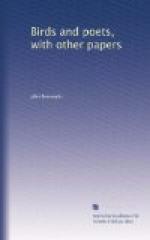. . . . . . . . . . .
The bird that occupies the second place to the nightingale in British poetical literature is the skylark, a pastoral bird as the Philomel is an arboreal,— a creature of light and air and motion, the companion of the plowman, the shepherd, the harvester,—whose nest is in the stubble and whose tryst is in the clouds. Its life affords that kind of contrast which the imagination loves,—one moment a plain pedestrian bird, hardly distinguishable from the ground, the next a soaring, untiring songster, reveling in the upper air, challenging the eye to follow him and the ear to separate his notes.
The lark’s song is not especially melodious, but is blithesome, sibilant, and unceasing. Its type is the grass, where the bird makes its home, abounding, multitudinous, the notes nearly all alike and all in the same key, but rapid, swarming, prodigal, showering down as thick and fast as drops of rain in a summer shower.
Many noted poets have sung the praises of the lark, or been kindled by his example. Shelley’s ode and Wordsworth’s “To a Skylark” are well known to all readers of poetry, while every schoolboy will recall Hogg’s poem, beginning:—
“Bird
of the wilderness,
Blithesome
and cumberless,
Sweet be thy matin o’er
moorland and lea!
Emblem
of happiness,
Blest
is thy dwelling-place—
Oh to abide in the desert
with thee!”
I heard of an enthusiastic American who went about English fields hunting a lark with Shelley’s poem in his hand, thinking no doubt to use it as a kind of guide-book to the intricacies and harmonies of the song. He reported not having heard any larks, though I have little doubt they were soaring and singing about him all the time, though of course they did not sing to his ear the song that Shelley heard. The poets are the best natural historians, only you must know how to read them. They translate the facts largely and freely. A celebrated lady once said to Turner, “I confess I cannot see in nature what you do.” “Ah, madam,” said the complacent artist, “don’t you wish you could!”
Shelley’s poem is perhaps better known, and has a higher reputation among literary folk, than Wordsworth’s; it is more lyrical and lark-like; but it is needlessly long, though no longer than the lark’s song itself, but the lark can’t help it, and Shelley can. I quote only a few stanzas:—
“In the golden
lightning
Of the sunken sun,
O’er which clouds are bright’ning
Thou dost float and run,
Like an unbodied joy whose race is just begun.
“The pale purple
even
Melts around thy flight;
Like a star of heaven,
In the broad daylight
Thou art unseen, but yet I hear thy shrill
delight,
“Keen as are the
arrows
Of that silver sphere,
Whose intense lamp narrows
In the white dawn clear,
Until we hardly see—we feel that
it is there;




